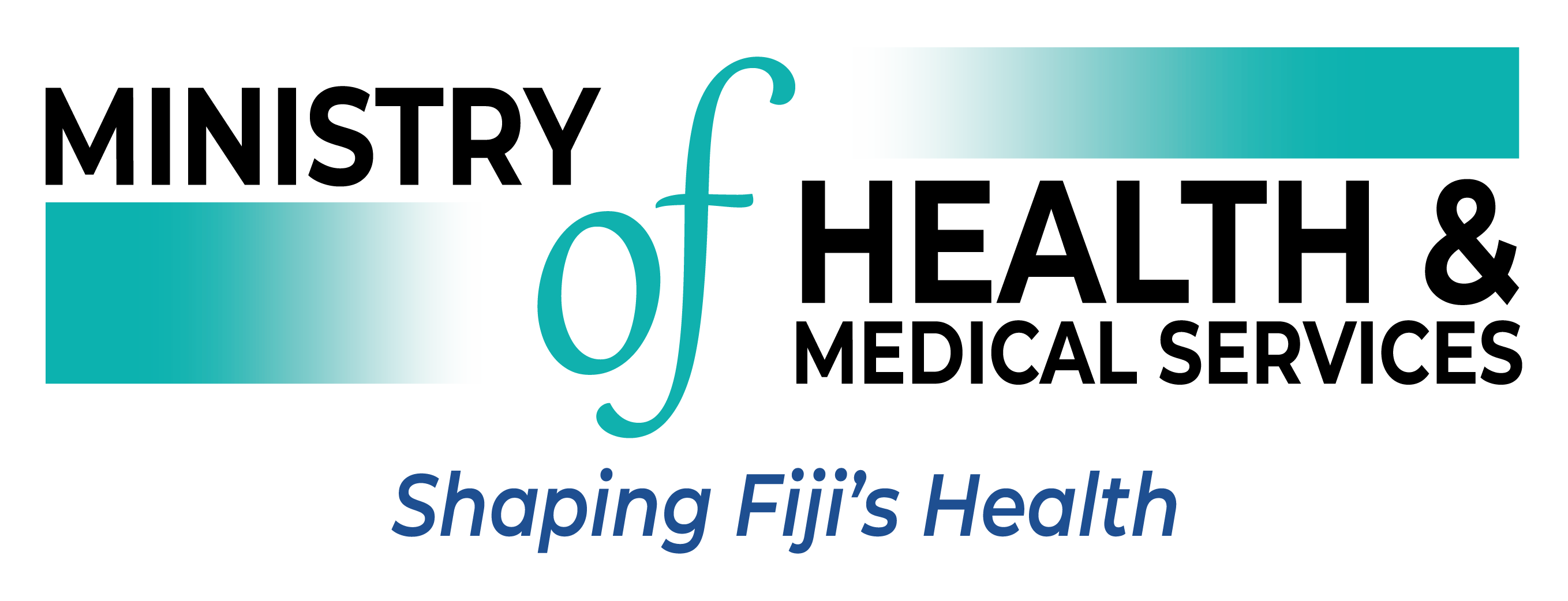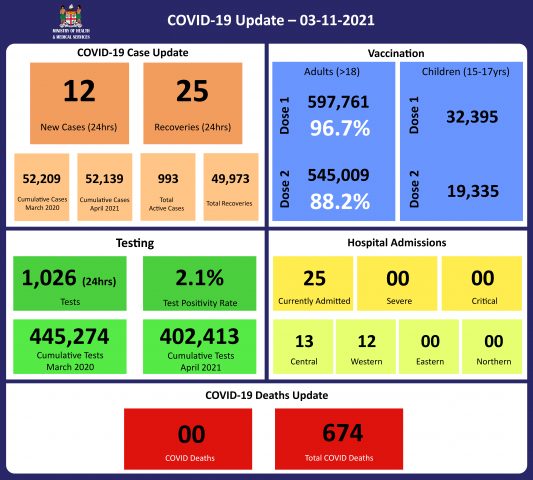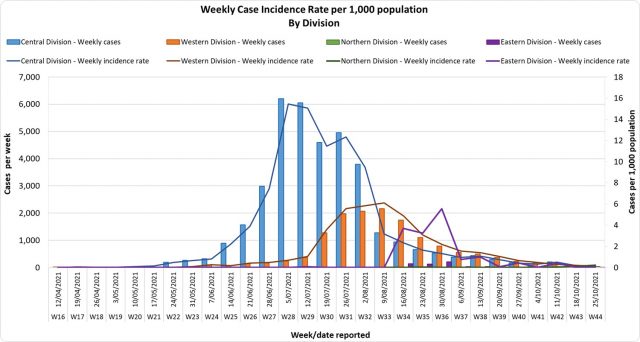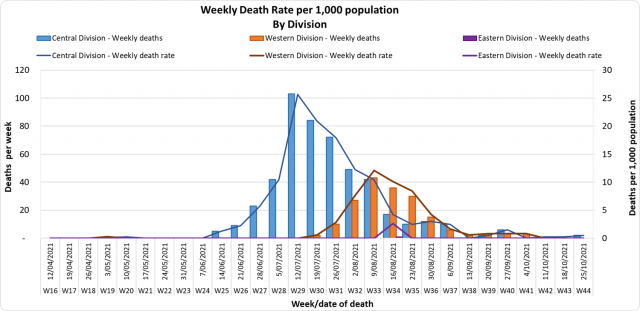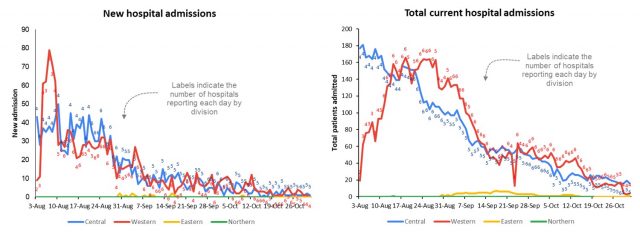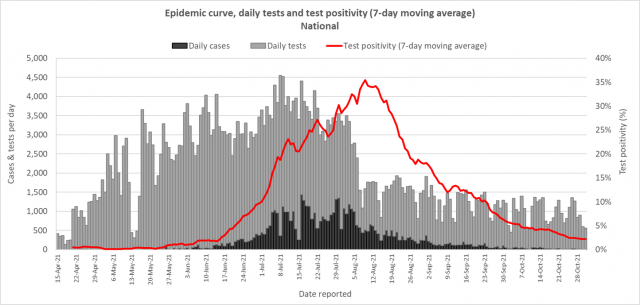COVID-19 Update – 03-11-2021
| Transmission Update:
In the past 7 days, 64 cases were recorded in the central division, 48 new cases in the western division, 2 new cases in the eastern division, and 33 new cases in the northern division. The central division cases constitute 71% of the cumulative total cases nationally, with the western division making up 28% and 1% in the northern and eastern divisions. The 33 new cases recorded in the north are quarantine cases that are part of the repatriation program for the northern division. There is ongoing surveillance conducted for all repatriates. Since the last update, we have recorded 30 new cases of which 18 new cases were recorded on 02/11/2021 and 12 new cases in the last 24 hours ending at 8 am this morning. The national 7-day rolling average of cases as of 30th October is 22 daily cases. The weekly incidence rate graph by division indicates a continually declining trend. Furthermore, the peak weekly incidence in the western division was approximately a third of that in the central division, and the cumulative case numbers are also reflecting a similar difference. |
| Deaths:
This curve depicts the weekly death rate per 1000 population by divisions since the 2nd wave of this outbreak began in April 2021. Overall the death rate graphs for the Central and Western Divisions indicate a declining trend. The differences between the Central and Western are similar to the incidence of the weekly cases and are likely a reflection of vaccination levels, COVID mitigation measures, and differences in population density. There is no COVID-19 death to report. There have been 674 deaths due to COVID-19 in Fiji, with 672 of these deaths during the outbreak that started in April this year. Please note that due to the time required by clinical teams to investigate, classify and report deaths, a 4-day interval is given to calculate the 7 days rolling average of deaths, based on the date of death, to help ensure the data collected is complete before the average is reported. Therefore, as of October 30th, the national 7 days rolling average of COVID-19 deaths per day is 0.3. The 7 days rolling average for COVID-19 deaths per day in the Central Division is 0.3 and 0.0 in the Western Division, with a case fatality rate of 1.29%. |
| Hospitalisation:
The downward trend in both the new hospital admissions and total admissions in all hospitals admitting COVID-19 patients across the country is consistent with the cases and death trends. The hospital admissions continue on a downward trend indicating a sustained positive response to COVID mitigation measures, Population density differences, and differential Vaccination rates. |
| Testing:
1,026 tests have been reported for November 2nd, 2021. The 7-day daily test average is 861 tests per day or 1.2 tests per 1,000 population. The national 7-day average daily test positivity is 2.1%, which is on a downward trend, and below the WHO recommendation of 5%, and this is illustrated by the lab testing graph; also noting the reduction in the daily number of cases. Though we continue testing in high-risk areas, our case numbers and test positivity rate continue to decrease, indicating a better control of the community transmission in Fiji through the combined efforts of containment and mitigation measures with ongoing community surveillance. |
Epidemic Outlook:
The Ministry of Health continues to monitor the outbreak using indicators such as daily case numbers, hospitalizations, test positivity, and deaths. There is a downward trend across all indicators of the COVID-19 epidemic in Fiji, indicating a positive response to our overall COVID containment and mitigation response.
Occupancy rates in health facilities, the occupancy rate of ICU beds, death rates, and vaccination coverage are indicators to monitor our health response capacity and we see a decreasing trend across indicators from our health facilities with increasing vaccination coverage for adults and 15-17-year-olds in Fiji.
Our weekly testing numbers of over 6,000 are still above the WHO recommended rate of 4 tests per 1,000 population per week (or approx. 3,500 tests per week) and we anticipate continued surveillance and testing in our communities and maritime islands to monitor and detect cases for early intervention.
Public Advisory:
A disease becomes endemic when it is expected to remain persistently present in the community. Some diseases endemic to Fiji are dengue fever and the common cold. These diseases persist at some level in the community and become epidemic when levels go beyond what is determined to be expected and acceptable. Determining what that acceptable level of disease is for COVID-19, is a work in progress but in general, it will be at the level which triggers additional control measures, Because COVID-19 is a vaccine-preventable disease, and the vaccines are very good at preventing severe disease and death, in a highly vaccinated population determining and monitoring acceptable levels, or thresholds, goes beyond case numbers. A disease that causes frequent cases in the community (like the common cold) but has a small impact on the numbers of people needing hospitalization or death, and minimal impact on the health system, will require less intervention. This is why we will be closely monitoring the following indicators: cases, test positivity, hospitalisations, and deaths.
Unfortunately, vaccine-related herd protection is not likely to be as efficient with COVID 19 as seen with some of the traditional vaccine-related diseases like measles. Recent data verified and released by the CDC indicate that unvaccinated people with the previous COVID 19 infection were 5 times more likely to have a positive covid 19 test compared to vaccinated people. As such unvaccinated people cannot rely on herd immunity (or herd protection) nor natural immunity to protect themselves. Those eligible must get vaccinated to reduce their risk of infection, severe disease, and death. And we know vaccines are very good in preventing severe disease and deaths.
This lower efficiency in vaccine-related herd immunity also means that the public will need to live with COVID safe measures of masking, hand washing, physical distancing, and good ventilation and/or air cleaning technology. These COVID safe measures remain vital in preventing the need to go back to severely restrictive public health measures.
Supporting School Re-opening
COVID-19 poses a lower risk to children however secondary transmission from young school-age children can and does occur in both household and school settings. Our vaccine deployment program for children aged 15 to 17 years is going well and we are planning on initiating Pfizer Vaccine deployment from the 15th of November for children aged 12 to 15 years. Conditions required to facilitate COVID safe school conditions have been discussed with the Ministry of Education and a training program to create awareness around COVID safe school conditions has been facilitated for senior education officials.
We note the recent news that the FDA has issued emergency approval for Pfizer to be given to children aged 5 to 11 years, with a pediatric dose of one-third that is given to adults and adolescents. This pediatric dose is given as two shots three weeks apart and is considered by the FDA to be safe and 90% effective.
Travel to the North
For the North, the Ministry of Health and Medical Services is supporting a repatriation program and not a social travel program. As such travel for short-term goals is likely to be adversely affected if a person turns out positive while in quarantine. We are doing all we can to improve vaccination coverage in the North and we will review these quarantine measures for local travel after the 11th of November.
Last Updated on 3 years by Publishing Team
